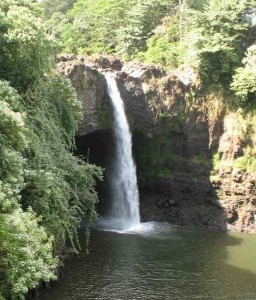Waterless Rainbow Falls Stirs Debate
An unusual thing happened a week ago. Rainbow Falls, located in the rainiest city in the nation, went dry.
The falls is a regular stop for tour buses and vans. During times of heavy rain it also draws many East Hawaii residents who come to watch the Wailuku River thunder over it, creating the mists which produce the falls’ namesake effect.
But weather conditions lately have not been of the rainbow-generating type. Most Big Island rain gauges — even some on the wetter windward side — have recorded well below normal levels.
Data from the National Weather Service show that rainfall up in the Piihonua section of Hilo, through which the Wailuku flows, has been running at about one-third of normal levels over the past two months.
Higher up on the slopes of Mauna Kea, where the Wailuku begins, it has been even drier. Two rain gauges in that area have received about 15% of normal rainfall over that period.
Apparently Rainbow Falls has been waterless before.
Kevin Kodama, a hydrologist for the National Weather Service office in Honolulu, said he has been told that it has happened in the past.
Since this is not the sort of thing that is documented, at least not by the weather service, Kodama could not provide any firm dates. He said it could have happened during another particularly dry period in December 1978.
Dean Takebayashi, Big Island superintendent for the state Parks Division, which maintains The Wailuku River State Park that includes Rainbow Falls, said his staff recalls it happening before, but not lately.
But dry weather doesn’t necessarily tell the whole story.
A 6-foot-diameter intake pipe for Hawaii Electric Light Co. is located about 100 feet above the falls. The intake feeds the utility’s Puueo Hydroelectric Plant located down on Wainaku Street, several blocks from the ocean.
Troy Keolanui, co-proprietor of OK Farms, a 500-acre diversified agriculture operation on the Hamakua side of Rainbow Falls, believes that intake – located on an easement on the farm – played a major role in the falls going dry.
“The HELCO plant was still running when the falls went dry,” Keolanui said, adding that he believed in the past that HELCO turned down the turbines during dry times.
Both were confirmed by Norman Verbanic, manager of HELCO’s production department. He said on Dec. 4 the Puueo plant was running, albeit at a reduced rate. He said that day the plant was producing on average about 1 megawatt of electricity, about one-third of its capacity.
Curtis Beck, HELCO’s manager of energy services, said it is understandable that people might think that the intake was the reason the falls ran dry.
“Naturally, if we divert water it would affect the falls,” he said.
But Verbanic was adamant that the intake was not the reason the falls ran dry. He said the intake pipe built in the early 1900s was placed on the side of the river and cannot capture all of the Wailuku’s water.
“We are capturing the natural flow that goes into the diversion,” he said.
Verbanic said during dry periods, the plant’s turbines are ratcheted down to maintain the steady water pressure in the supply pipe needed to protect the equipment.
He said there are also times — the most recent several years ago – when both the Puueo plant and HELCO’s other hydroelectric facility, the Waiau Hydroelectric Plant further up the river, were shut down because of a lack of water.
But such talk doesn’t sway Keolanui.
“It steams me,” he said, calling the falls “a sacred place for the Hawaiians.”
He added that he has told people that if they want to see Rainbow Falls they would have to go down to the Wainaku Street bridge, which is just below the Puueo plant’s discharge.
But others say the situation isn’t that straightforward.
Takebayashi of state parks said the intake doesn’t take all the water.
“There’s always the possibility that some of the water is being sapped out by lava tubes,” he said.
Kodama, the weather service hydrologist, agrees.
He said the complex hydrology of East Hawaii with its lava tubes, cracks and crevices can “really mess up” a river’s flow profile.
So this debate may be renewed again. Or not.
A recent study done by the East-West Center and funded by the National Oceanic and Atmospheric Administration notes that rainfall in Hawaii has gradually decreased over the past century.

And this is what the falls looks like in far less arid times. Photo courtesy of the Hilo Downtown Improvement Association.
About a decade ago, the National Weather Service lowered by several inches the average rainfall figure for Hilo’s airport, which is based on data from the previous 30 years.
But that still left the relatively dry lower part of Hilo averaging more than 10 feet of rain annually, which means precipitation anywhere near normal in East Hawaii could render the matter moot.











